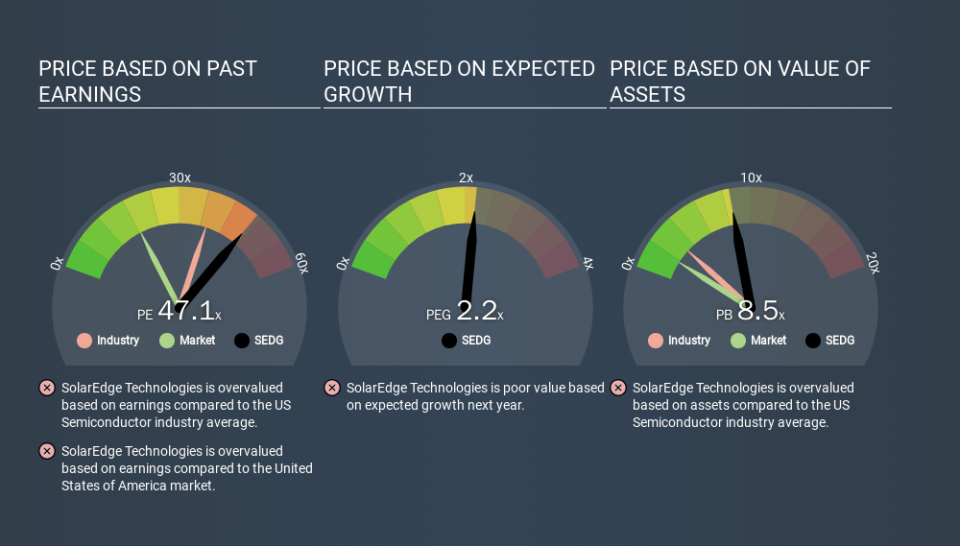A Rising Share Price Has Us Looking Closely At SolarEdge Technologies, Inc.'s (NASDAQ:SEDG) P/E Ratio

It's really great to see that even after a strong run, SolarEdge Technologies (NASDAQ:SEDG) shares have been powering on, with a gain of 31% in the last thirty days. That's tops off a massive gain of 241% in the last year.
All else being equal, a sharp share price increase should make a stock less attractive to potential investors. While the market sentiment towards a stock is very changeable, in the long run, the share price will tend to move in the same direction as earnings per share. The implication here is that deep value investors might steer clear when expectations of a company are too high. Perhaps the simplest way to get a read on investors' expectations of a business is to look at its Price to Earnings Ratio (PE Ratio). A high P/E implies that investors have high expectations of what a company can achieve compared to a company with a low P/E ratio.
Check out our latest analysis for SolarEdge Technologies
Does SolarEdge Technologies Have A Relatively High Or Low P/E For Its Industry?
SolarEdge Technologies's P/E of 47.13 indicates some degree of optimism towards the stock. As you can see below, SolarEdge Technologies has a higher P/E than the average company (38.2) in the semiconductor industry.
Its relatively high P/E ratio indicates that SolarEdge Technologies shareholders think it will perform better than other companies in its industry classification. The market is optimistic about the future, but that doesn't guarantee future growth. So investors should delve deeper. I like to check if company insiders have been buying or selling.
How Growth Rates Impact P/E Ratios
Generally speaking the rate of earnings growth has a profound impact on a company's P/E multiple. If earnings are growing quickly, then the 'E' in the equation will increase faster than it would otherwise. That means even if the current P/E is high, it will reduce over time if the share price stays flat. And as that P/E ratio drops, the company will look cheap, unless its share price increases.
SolarEdge Technologies's earnings per share grew by -5.9% in the last twelve months. And its annual EPS growth rate over 3 years is 25%.
Don't Forget: The P/E Does Not Account For Debt or Bank Deposits
The 'Price' in P/E reflects the market capitalization of the company. That means it doesn't take debt or cash into account. In theory, a company can lower its future P/E ratio by using cash or debt to invest in growth.
While growth expenditure doesn't always pay off, the point is that it is a good option to have; but one that the P/E ratio ignores.
How Does SolarEdge Technologies's Debt Impact Its P/E Ratio?
The extra options and safety that comes with SolarEdge Technologies's US$314m net cash position means that it deserves a higher P/E than it would if it had a lot of net debt.
The Verdict On SolarEdge Technologies's P/E Ratio
SolarEdge Technologies has a P/E of 47.1. That's higher than the average in its market, which is 18.5. Earnings improved over the last year. And the net cash position provides the company with multiple options. The high P/E suggests the market thinks further growth will come. What is very clear is that the market has become significantly more optimistic about SolarEdge Technologies over the last month, with the P/E ratio rising from 36.0 back then to 47.1 today. If you like to buy stocks that have recently impressed the market, then this one might be a candidate; but if you prefer to invest when there is 'blood in the streets', then you may feel the opportunity has passed.
Investors have an opportunity when market expectations about a stock are wrong. As value investor Benjamin Graham famously said, 'In the short run, the market is a voting machine but in the long run, it is a weighing machine. So this free visual report on analyst forecasts could hold the key to an excellent investment decision.
Of course, you might find a fantastic investment by looking at a few good candidates. So take a peek at this free list of companies with modest (or no) debt, trading on a P/E below 20.
If you spot an error that warrants correction, please contact the editor at editorial-team@simplywallst.com. This article by Simply Wall St is general in nature. It does not constitute a recommendation to buy or sell any stock, and does not take account of your objectives, or your financial situation. Simply Wall St has no position in the stocks mentioned.
We aim to bring you long-term focused research analysis driven by fundamental data. Note that our analysis may not factor in the latest price-sensitive company announcements or qualitative material. Thank you for reading.



